
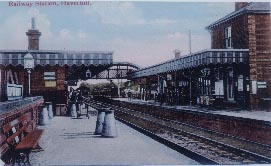
Harrod’s Commercial Directory for 1864 contains the
following in the entry for Haverhill: “It is a respectable market
town…… well supplied with railway communications at present,
forming the terminus of the Colne Valley Railway, joining the trunk line
of the Great Eastern Railway at Marks Tey.
An extension of the Great Eastern line connecting Sudbury with Cambridge
is in course of construction, which, running through the centre of town,
will give the manufacturing trades increased facilities for export.”
Well, Haverhill is still a respectable town with a popular, albeit somewhat smaller, market, but the railway has long since gone.
Many of the expectations deriving from ‘the coming of the railway’ were fully satisfied, especially in light of the fact that the town never had a navigable waterway via which to export its goods (as did Sudbury).
Stour Brook was never large enough to accommodate commercial river traffic, and Haverhill always had to rely on its road connections (particularly its position on the busy Cambridge to Colchester road) to import any necessary raw materials (including food) and to sell its manufactured products. The stagecoach to London, via Saffron Walden and Bishops Stortford was the "Telegraph" which left the Bell Hotel on Mondays, Wednesdays and Fridays. The "Accommodation" ran from Colchester to Cambridge, calling at the Greyhound Inn (now Lloyds Bank) on Monday, Wednesday and Friday, returning on Tuesday, Thursday and Saturday.
Five carriers provided transport to London once a week from the Greyhound or the Rose and Crown. Carriers to Clare, Cambridge and Colchester ran twice a week.
Once Haverhill was part of the railway network, everyday necessities, such as coal, fertilizers, building materials, and mass-produced foodstuffs,
HAVERHILL AND THE AGE OF STEAM
By Ian Hornsey
Tesco’s is coming to town.
Planning permission was granted in the summer of 2008 to allow the giant
supermarket to build a brand new store right in the centre of Haverhill.
Architects have chosen the old railway station as the site for the new
building, which places the superstore only a short walk away from Haverhill
High Street. So before memories of the old rail links fade completely
we look at how the railway once dominated the life and trade of Haverhill.
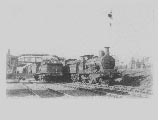
HAVERHILL STATION
suddenly became cheaper. The railway was to underpin the relative prosperity of the town for the next hundred-odd years.
Soon after the railway reached Haverhill, the town saw an increase in business activity, and, amongst other events: Gurteens built a second factory, Vanners built a silk factory (both in 1865), and Taylor’s flour mill was erected in the early 1870s. There was a general increase in employment opportunity, and the town’s population increased to around 3,700 (from ca.2150 thirty years earlier).
Britain’s ‘main line’ railways, which connected cities and major towns had been largely constructed by 1860 – a mere thirty years after Stephenson’s Liverpool & Manchester Railway first carried passengers quicker than the speed of an animal!
Much of the network was laid down as a result of ‘The
Year of Railway Mania’ – 1845, when no fewer than 650 railway
Acts were passed by Parliament (these authorised the construction of over
9,000 miles of track).
Such Acts were essential because railway construction invariably involved
the compulsory purchase of land, and all that went with it.
To be left off of the railway network could be disastrous, and, even by 1850, it was considered commercial suicide to attempt to run a business in an area without trains. Thus, the immediate post-1860 years saw the ‘filling-in’ of the railway network as towns and villages all vied to be included in railway timetables.
New line followed new line as gangs of navvies moved around the countryside. There might be 2,000 men and 300 horses employed tipping some 2,500 wagons a day, each containing 2½ cubic yards of earth, for a single embankment, or the same number of men split between half a dozen gangs over a line eight miles long; 500 men could be concentrated on building a single bridge or over 1,000 on a single tunnel, often working in shifts round the clock, tearing through hills and filling in valleys to create as level a route as possible.
Sometimes, railway-buildings leave long-lasting legacies
in the countryside.
One fairly local example of this is the still functioning Thatcher’s
Arms at Mount Bures, which reputedly opened as a beerhouse in the late
1840s to accommodate the thirsts of the workmen building the nearby Chappel
Viaduct, the largest engineering project on the Haverhill to Colchester
line.
The viaduct, for which construction work began in 1847, crossed the extensive valley of the River Colne at Chappel, which was the greatest natural obstacle between Marks Tey and Sudbury. Marks Tey was on the Eastern Counties railway (ECR), which opened from Shoreditch (London) to Colchester in March 1843, and became the junction for what was eventually the Cambridge line.
Costing some £32,000, the brick-built structure took two years to complete, was 1066 feet long, with 32 arches of 30 feet span each, and a height of 75 feet. Around 7 million bricks were used in its construction, which involved over 600 men and a team of about 100 horses! The viaduct, which is the finest tribute to Victorian railway engineering in East Anglia, is now a listed monument. A commemorative foundation stone was laid into the fourth arch looking towards Marks Tey on 14th September 1847, and this is still clearly visible from the Colchester road.
The First Line to Town
The first line to reach Haverhill was that of the Colne Valley & Halstead Railway (CV&HR) on June 18th 1860, an event that linked the town with Halstead.
Initially, temporary station buildings were used because the permanent structure (later to be called Haverhill South) had not yet been completed (the CV&HR was always short of cash). The company also built locomotive repair sheds in the station yard, although these were relocated to Halstead in 1908. Between Haverhill and Halstead, this line had intermediate stations at: Birdbrook, Yeldham, and Sible & Castle Hedingham.
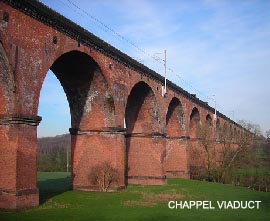
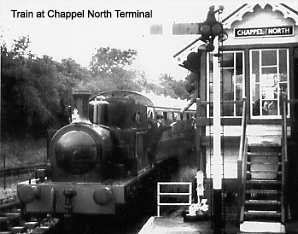
In 1865, the Great Eastern Railway (GER) arrived in town
from Cambridge and set up their Haverhill North Station.
Exactly how the GER reached Haverhill is the story of a series of rather
protracted and convoluted processes – involving a number of small
(and sometimes short-lived) companies all of whom were fierce competitors.
This particular story starts in 1846, when the Colchester, Stour Valley, Sudbury & Halstead Railway (CSVS&HR) obtained parliamentary authorisation to build a twelve mile line between Marks Tey and Sudbury. On 1st June the following year, further Acts were obtained to allow the company to extend the line to Clare, with a branch from Long Melford to Bury St Edmunds. The long term plan was to link up with Haverhill and obtain the lucrative Haverhill trade. Not surprisingly the existing train operators in Haverhill objected and proposed an alternative scheme of their own.
The arguments continued for many years until in 1862, much of the bickering ceased following an amalgamation of many smaller companies and the Great Eastern Railway (GER) was born.
The Act resulting in the formation of the GER renewed the authorisation of previously proposed lines, and, as a result, Haverhill was connected to the system. The line from Shelford to Haverhill opened on 1st June 1865, and the section from Haverhill to Sudbury followed on 9th August that year.
The formation of the Great Eastern Railway (GER) was a painful process with many legal difficulties and financial problems but it finally came into existence in 1862 allowing the Haverhill North line to be extended in 1865 to join up with Sudbury
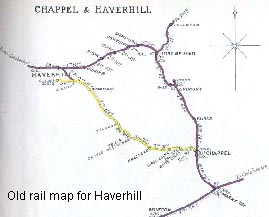
Part 2 - Haverhills Age of Steam